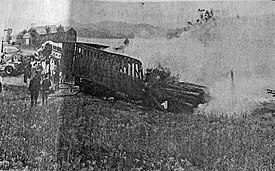1972 Bean Station, Tennessee bus crash
The 1972 Bean Station, Tennessee bus crash was a head-on collision involving a double-decker Greyhound bus and a tractor-trailer on U.S. Route 11W in Grainger County, Tennessee, that occurred near the town of Bean Station on the morning of May 13, 1972.[2][3]
| 1972 Bean Station, Tennessee bus crash | |
|---|---|
 | |
| Details | |
| Date | May 13, 1972 5:35 a.m. |
| Location | U.S. Route 11W 5.2 mi (8.4 km) west from Bean Station, Tennessee |
| Coordinates | 36.3310084°N 83.3691425°W |
| Country | United States |
| Operator | Greyhound |
| Incident type | Head-on collision |
| Cause | Operator error, distracted driving[1] |
| Statistics | |
| Bus | 1 |
| Vehicles | 1 (tractor-trailer) |
| Passengers | 27 (bus), 1 (tractor-trailer) |
| Deaths | 14 |
| Injuries | 15 |
The accident is considered one of the deadliest and worst traffic collisions in the history of the state of Tennessee.[4][5] The accident led to outcry from politicians and citizens calling for traffic safety and infrastructure improvements, such as highway widenings, and the completion of Interstate 81 in Tennessee.[6]
Incident

Around 4:45 a.m, the double-decker bus operated by Greyhound departed from Knoxville en route to Roanoke, Virginia. The bus had traveled eastward along US-11W for 42.4 miles in 50 minutes, averaging a speed of 50 miles per hour. The tractor-trailer had departed at 8:53 a.m. on the previous day from a manufacturing facility in Lancaster, Pennsylvania, en route to Memphis. The tractor-trailer had driven 517 miles west in a period of 20.5 hours before reaching the site of the accident.[7]
The Greyhound bus had approached the site tailing a slow-moving car in the eastbound lane around 5:35 a.m. The bus then attempted to pass the automobile by crossing into the oncoming westbound lane, into the path of the tractor-trailer. The two vehicles then collided head-on at a combined speed of 100 miles per hour, killing the truck driver, bus driver, and 12 of the bus's passengers instantly.[8]
Investigation

The National Transportation Safety Board (NTSB) began an investigation on the crash in 1973 and completed a 38 page report on the collision. This report was then issued to the public in February 1974.[9]
The NTSB concluded that the probable cause of the collision was the Greyhound bus driver's attempt to pass the automobile with the view of the westbound semi-truck being obstructed.[1] The driver also failed to avoid the truck for unknown reasons.[1]
The lack of restraints for passengers of the bus contributed to several fatalities of those on-board by ejection from the bus.[1]
Aftermath
Led by the widow of one of the passengers aboard the bus, survivors of the crash and other family members of the victims filed a federal lawsuit against Greyhound for 2.5 million dollars. The jury found Greyhound at fault for failing to take action for the driver of the bus, who had a history of diabetes, heart and liver disease, and several other severe medical conditions.[4]

Individuals ranging from activists, state and local politicians, engineers, and journalists considered the collision a call to action for the widening of heavily trafficked highways in the state such as U.S. 11W and the completion of then under construction Interstate 81 from Bristol to Dandridge, which paralled the route of 11W.[6]
Because of the heavy truck traffic on that highway (US-11W), it was just a matter of time until something like this happened.
Governor Winfield Dunn called for action to widen 11W from two to four lanes in its entirety from Kingsport to Knoxville,[4] stating:
The record of Highway 11W is written in tragedy and demands the action of responsible people including the governor, This I intend to do.
— Governor Winfield Dunn
As of the present day, U.S. Route 11W has since been widened to four lanes, except for the nearly 30 mile stretch between Blaine and Bean Station, including where the collision had occurred. It is been suggested that NIMBYism from citizens in Grainger County has played a significant role in the prevention and postponement of the highway construction.[11]
In 2020, the Tennessee Department of Transportation (TDOT) had completed the right-of-way acquisition phase of the 11W widening project between Rutledge and Bean Station, expecting to begin construction in 2021-2022.[12]
References
- "GREYHOUND BUS/MALONE FREIGHT LINE, INC. TRUCK COLLISION" (PDF). National Transportation Safety Board. October 25, 1973. Retrieved May 6, 2020.
- "14 Die in Tennessee Bus Truck Crash". New York Times. May 14, 1972. Retrieved May 6, 2020.
- Wolfe, Tracey (June 24, 2020). "Victim reunites with rescue workers 48 years after deadly crash". Grainger Today. Retrieved June 25, 2020.
- Lakin, Matt (August 26, 2012). "Blood on the asphalt: 11W wreck left 14 people dead". Knoxville News Sentinel. Retrieved May 6, 2020.
- Ahillen, Steve (October 3, 2013). "Jefferson wreck echoes Tennessee's most deadly bus accident". Knoxville News Sentinel. Retrieved July 14, 2020.
- Beitler, Stuart (May 14, 1972). "11-W Disaster Brings New Highway Pleas". Kingsport Times-News.
- Coggins, Allen R. (January 15, 2012). Tennessee Tragedies: Natural, Technological, and Societal Disasters in the Volunteer State. Knoxville, Tennessee, United States: University of Tennessee Press. p. 155. ISBN 1572338296.
- Campbell, Thomas (July 3, 2020). "BEAN STATION: One of worst accidents in state history occurred 48 years ago on "Bloody Highway 11W"". The Rogersville Review. Retrieved July 4, 2020.
- Osborne, J.H. (May 17, 2020). "Federal agency investigated 1972 Bean Station bus crash". Kingsport Times-News. Retrieved May 27, 2020.
- Osborne, J.H. (May 14, 2020). "I'd never heard the song "11 W Bloody Highway" until Wednesday". Kingsport Times-News. Retrieved July 19, 2020.
- Bade, Brittany (March 14, 2017). "Highway 11W expansion will force property owners to sell". WBIR Channel 10 News. Retrieved June 16, 2020.
- State of Tennessee, Tennessee Department of Transportation. "State Route 1 (US 11W) Improvements". preprod.tn.gov. Retrieved June 16, 2020.